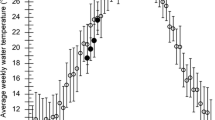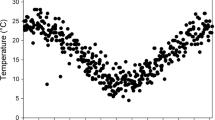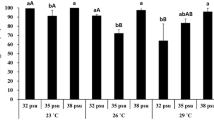Synopsis
Spawning of razorback suckers,Xyrauchen texanus, in Lake Mohave occurred from 10–22°C and larvae were collected at water temperatures from 10–15°C in 1982 and 1983. In the laboratory, hatching success was similar from 12–20°C, but reduced hatching success was found at 10°C while none hatched a 8°C. Development rate and oxygen consumption were positively related to incubation temperature. Direct effects of ambient Lake Mohave water temperatures on hatching success of razorback sucker embryos are considered minimal. Historical spawning temperatures for the species are hypothesized based upon successful incubation temperatures and comparison to the white sucker,Catostomus commersoni.
Similar content being viewed by others
References cited
Alabaster, J.S. & R. Lloyd. 1980. Water quality criteria for freshwater fish. Butterworths, London. 297 pp.
Balon, E.K. 1984. Reflections on some decisive events in the early life of fishes. Trans. Amer. Fish. Soc. 113: 178–185.
Bozek, M.A. 1984. Factors affecting the reproductive success of razorback suckers and bonytail chubs in Lake Mohave, Arizona-Nevada during 1982–1983. M.S. Thesis, University of Nevada-Las Vegas, Las Vegas. 149 pp.
Chandler, G.L. & T.C. Bjornn. 1988. Abundance, growth, and interactions of juvenile steelhead relative to time of emergence. Trans. Amer. Fish. Soc. 117: 432–443.
Cloud, J.G., A.L. Erdahl & E.F. Graham. 1988. Survival and continued normal development of fish embryos after incubation at reduced temperatures. Trans. Amer. Fish. Soc. 117: 503–506.
Colby, P.J. & L.T. Brooke. 1973. Effects of temperature on embryonic development of lake herring (Coregonus artedii). J. Fish. Res. Board Can. 30: 799–810.
Corbett, B. & P.M. Powles. 1983. Spawning and early-life ecological phases of the white sucker in Jack Lake, Ontario. Trans. Amer. Fish. Soc. 112: 308–313.
Coutant, C.C. 1987. Poor reproductive success of striped bass from a reservoir with reduced summer habitat. Trans. Amer. Fish. Soc. 116: 154–160.
Cushing, D.H. 1982. Climate and fisheries. Academic Press, London. 373 pp.
Douglas, P.A. 1952. Notes on the spawning of the humpback suckerXyrauchen texanus (Abbott). California Fish and Game 38: 149–155.
Fausch, K.D. & R.J. White. 1986. Competition among juveniles of coho salmon, brook trout, and brown trout in a laboratory stream, and implications for Great Lakes tributaries. Trans. Amer. Fish. Soc. 115: 363–381.
Fuiman, L.A. 1979. Descriptions and comparisons of catostomid larvae and Northern Atlantic drainage species. Trans. Amer. Fish. Soc. 108: 560–603.
Geen, G.H., T.G. Northcote, G.F. Hartman & C.C. Lindsey. 1966. Life histories of two species of catostomid fishes in Sixteen Mile Lake, British Columbia, with particular reference to inlet stream spawning. J. Fish. Res. Board Can. 23: 1761–1788.
Gutreuter, S.J. & R.O. Anderson. 1985. Importance of body size to the recruitment process in largemouth bass populations. Trans. Amer. Fish. Soc. 114: 317–327.
Hoar, W.S. & D.J. Randall. 1969. Fish physiology, vol. 3. Academic Press, New York. 485 pp.
Holden, J.P. 1978. A study of the habitat and movement of the rare fishes in the Green River, Utah. Trans. Amer. Fish. Soc. 107: 64–89.
Holden, J.P. & C.B. Stalnaker. 1975. Distribution of fishes in the Delores and Yampa River systems of the upper Colorado basin. Southwestern Naturalist 19: 403–412.
Johnson, J.E. & J.N. Rinne. 1982. The endangered species act and Southwestern Fishes. Fisheries 7: 2–8.
Kaeding, L.R. & D.B. Osmundson. 1988. Interaction of slow growth and increased early-life mortality: an hypothesis on the decline of Colorado squawfish in the upstream regions of its historic range. Env. Biol. Fish. 22: 287–298.
Kallemeyn, L.W. 1987. Correlations of regulated lake levels and climatic factors with abundances of young-of-the-year walleye and yellow perch in four lakes in Voyageurs National Park. North Amer. J. Fish Manag. 7: 513–521.
Marsh, P.C. 1985. Effect of incubation temperature on survival of embryos of native Colorado River fishes. Southwestern Naturalist 30: 129–140.
Marsh, P.C. & D.R. Langhorst. 1988. Feeding and fate of wild larval razorback suckers. Env. Biol. Fish. 21: 59–67.
Mason, J.C. & D.W. Chapman. 1965. Significance of early emergence, environmental rearing capacity, and behavioral ecology of juvenile coho salmon in stream channels. J. Fish. Res. Board Can. 22: 173–190.
McAda, C.W. & R.S. Wydoski. 1980. The razorback sucker,Xyrauchen texanus, in the upper Colorado River basin, 1974–1976. U.S. Fish and Wildlife Service Technical Paper No. 99. 15 pp.
McCarthy, M.S. & W.L. Minckley. 1987. Age estimation for razorback sucker (Pisces: Catostomidae) from Lake Mohave, Arizona and Nevada. Journal of the Arizona-Nevada Academy of Science 21: 87–97.
McCormick, J.H., B.R. Jones & K.E.F. Hokanson. 1977. White sucker (Catoosoomus commersoni) embryo development and early growth and survival at different temperatures. J. Fish. Res. Board Can. 34: 1019–1025.
Minckley, W.L. 1983. Status of the razorback sucker (Xyrauchen texanus, Abbott), in the lower Colorado River basin. Southwestern Naturalist 28: 165–187.
Minckley, W.L. & E.S. Gustafson. 1982. Early development of the razorback suckerXyrauchen texanus (Abbott). Great Basin Naturalist 42: 553–561.
Paulson, L.J., J.R. Baker & J.E. Deacon. 1980a. The limnological status of Lake Mead and Lake Mohave under present and future power-plant operations of Hoover Dam. Lake Mead Limnological Research Center Technical Report No. 1. University of Nevada-Las Vegas, Las Vegas. 229 pp.
Paulson, L.J., T.G. Miller & J.R. Baker. 1980b. Influence of dredging and high discharge on the ecology of Black Canyon. Lake Mead Limnological Research Center Technical Report No. 2. University of Nevada-Las Vegas, Las Vegas. 59 pp.
Raney, E.C. & D.A. Webster. 1942. The spring migration of the common white sucker,Catostomus c. commersoni (Lacepede), in Skaneateles Lake inlet, New York. Copeia 1942: 139–148.
Reckahn, J.A. 1986. Long-term cyclical trends in growth of lake whitefish in South Bay, Lake Huron. Trans. Amer. Fish. Soc. 115: 787–804.
Serns, S.L. 1984. First-summer survival, eggs to juveniles, of smallmouth bass in Nebish Lake, Wisconsin. Trans. Amer. Fish. Soc. 113: 304–307
Snyder, D.E. 1981. Contributions to a guide on the cypriniform fish larvae of the upper Colorado River system in Colorado. Bureau of Land Management Biological Science Series No. 3, Denver. 81 pp.
Toney, D.P. 1974. Observations on the propagation and rearing of two endangered fish species in a hatchery environment. Proceedings of the Western Association of State Game and Fish Commissioners 54: 252–259.
Tyus, H.M. 1987. Distribution, reproduction, and habitat use of the razorback sucker in the Green River, Utah, 1979–1986. Trans. Amer. Fish. Soc. 116: 111–116.
Vanicek, C.D., R.H. Kramer & D.R. Franklin. 1970. Distribution of Green River fishes in Utah and Colorado following the closure of Flaming Gorge. reservoir. Southwestern Naturalist 14: 297–315.
Wicker, A.M. & W.E. Johnson. 1987. Relationships among fat content, condition factor, and first year survival of Florida largemouth bass. Trans. Amer. Fish. Soc. 116: 264–271.
Winberg, G.G. 1956. Rate of metabolism and food requirements of fishes. Fish. Res. Board Can. Transl. Ser. No. 194. 253 pp.
Author information
Authors and Affiliations
Rights and permissions
About this article
Cite this article
Bozek, M.A., Paulson, L.J. & Wilde, G.R. Effects of ambient Lake Mohave temperatures on development, oxygen consumption, and hatching success of the razorback sucker. Environ Biol Fish 27, 255–263 (1990). https://doi.org/10.1007/BF00002744
Received:
Accepted:
Issue Date:
DOI: https://doi.org/10.1007/BF00002744




